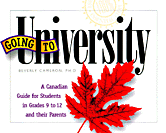


|
Going to University: A Canadian Guide for Students in Grades 9 to 12 and
Their Parents.
Beverly Cameron. Subject Headings:
Grades 9 and up / Ages 14 and up. ** /4
|

excerpt:
You may be able to visit two schools in one day. For example, the University of Manitoba in the morning and the University of Winnipeg in the afternoon, Université d' Ottawa in the morning and Carleton University in the afternoon, Simon Fraser University in the morning and the University of British Columbia in the afternoon, York University in the morning and the University of Toronto in the afternoon, Waterloo University in the morning and Wilfrid Laurier University in the afternoon. It's also possible to do an intensive two day trip and visit several schools. For instance the University of Victoria one day and the University of British Columbia and Simon Fraser the next, the University of Western Ontario one day and the Universities of Guelph and Waterloo the next day, Queen's University one day and McGill University and Université de Montreal the next day, Dalhousie University one day and Mount Saint Vincent and Saint Mary's University the next day, the University of Regina one day and the University of Saskatchewan the next, the University of Alberta one day and the University of Calgary the next, and Mount Allison University one day and St. Thomas University and the University of New Brunswick the next day. Many other combinations can be arranged if you have one or more days.Beverly Cameron's Going to University begins by discussing the reasons Canadian students and parents are looking more carefully at their options for a university education. This guide, Cameron explains, is designed to help them look by:
Within those limits, this slim book does its job. Going to University doesn't rate or recommend universities, or help students decide what field of study is right for them, but it does provide some very basic information about going to university. Primarily, however, it contains lists - rather like those guides on how to plan for a wedding. Some are checklists for what a high school student should do to prepare in the years and months leading up to graduation; some are lists of questions students should ask themselves and representatives of prospective universities to ensure a good fit; some are lists of methods that can help students determine their aptitudes and abilities; and most importantly, some are lists of other resources with information about specific universities, kinds of financial support, and so on.
- providing some basic information about Canadian and American universities,
- suggesting questions that students will need to find answers to as they make decisions about universities, and
- making suggestions on how students, their parents, and high school guidance counsellors can find the information to answer these questions.
Cameron's writing is generally clear, and should be accessible to
her target audience (although her unfortunate habit of using the Latin
abbreviation "e.g." rather than the English "for example" might confuse
some younger readers).
Much of the book, however, like the excerpt at the top of this
review, reads like padding. Example follows example, as Cameron lists or
discusses possibilities without providing advice. For instance, she
includes many resources for information on American universities, without
ever discussing why a Canadian student would want to attend one despite the
vastly higher tuition costs.
Similarly, she includes a long list of things students might want
to take with them to residence (including some as obvious as alarm clocks,
and others, like push pins or juice boxes, so easy to come by anywhere
they're not worth packing). But serious concerns about living in residence
- like whether it's better to just get an apartment, how to find food
that's both healthy and affordable, or the dealing with sex, room-mates, or
cockroaches - are left alone.
In all the lists there are odd omissions. Cameron assumes her
audience is familiar with the Internet, and often suggests web-sites or
Internet searches to find different kinds of information, but she never
mentions that libraries will contain many useful resources as well. In her criteria
for choosing a university she doesn't mention considering how well it would
prepare a student for further study at the graduate level. Nor does she
suggest asking an academic in a student's chosen field of study for
advice on the strengths of a given program at different universities.
The most fundamental problem with Going to University, however, is
its limited ambition. Should a student even go to university right after
high school? Many high school graduates would be better off working for a
year or two until they know themselves, and the world, a little better,
before they make such a crucial decision. Going to University doesn't
really help with choices that important.
Still, for students who have already decided, Going to University
provides some useful checklists and pointers to valuable resources.
Recommended with reservations
Duncan Thornton is an Instructor in the New Media program at Red River Community College in Winnipeg, and a former editor of CM. He has studied at four universities in three provinces.

To comment on this title or this review, send mail to cm@umanitoba.ca.
Copyright © 1996 the Manitoba Library Association. Reproduction for personal use is permitted only if this copyright notice is maintained. Any other reproduction is prohibited without permission.
Published by
The Manitoba Library Association
ISSN 1201-9364
AUTHORS |
TITLES |
MEDIA REVIEWS |
BOOKSHELF
BACK ISSUES |
SEARCH |
HOME